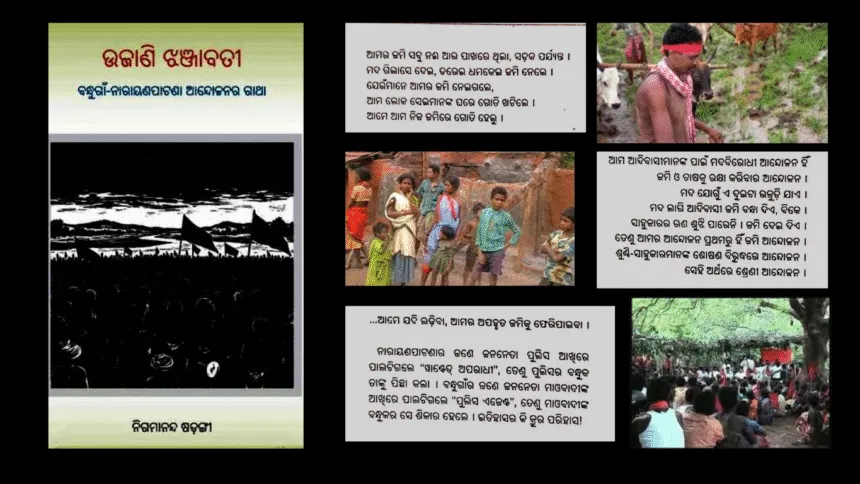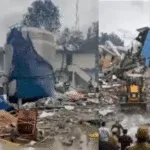When I first learnt of Nigamananda Sadangi’s designs for composing this book a couple of years ago on a phone call, I was filled with excitement. There were quite a few reasons for it. At first, it was an opportunity to witness a movement which I had only heard of, way back since I was in school, from the newspapers back in the day. I’d never been able to visit those places as I was too young then, and later college education had taken me far away from Odisha, so I remained at mercy of words. The other reason was that I knew there was a gaping hole in the literature that understood, studied and commented on the land-movements of Odisha, particularly on Narayanpatana. Dabbling in politics since early college days, I had been nearly frustrated in search to know more about Narayanpatana, and had barely found much on it, whereas Lalgarh and Telangana as well as Jharkhand and Chhattisgarh had reams of files on them. In any case, that was my first brush with the unborn idea, the flicker of hope, that finally the story will be told, the characters will be understood, and the fight will be represented in the literary world.
While the book was being written, at various stages Nigamananda— who is endearingly called Nigam Bhai— would call up, send in a draft and I would diligently read it and share my questions or comments, which he listened to seriously and we would end up discussing it at close length. I would never miss a chance to meet him, when I had the chance, and often looked forward to it. I’d learn about something new each time that I had always wished to, and perhaps that was what meant the most to me. Looking back, I’d never be able to say what good use was I of, except he was humble to take my views with such patience and grace and let me speak to him. I knew this book was my key to understand the world a little more. Thus, my intention here, as I mention in the title, is not as such to ‘review’ the book, but to attempt to place it for a reader— like me— who found in the book a place to engage with a place one so dearly loves and belongs— Odisha.
At the outset, ‘Ujaani Jhanjabati’ is a fascinating attempt to record the journey of a people’s movement from the point of view its participants. Unlike histories that authorize themselves with glorification and damnation—the two sides of the same coin—this book is an attempt to sketch the highs and lows, the gains and setbacks, the dynamic vivacity of a people’s movement which has at its heart the human condition. In other words, Sadangi’s book tries to tell the tale of a movement by considering the human sentiments that make it: a politics that is sensitive to its players’ internal world. For instance, the long and often verbatim quotations from his respondents often make one lose the narrator’s presence and puts the reader in the place of the people, allowing them to not be swayed by impressions, but witness the movement as it unfolded, really. This, after all, is the gift of oral histories, especially ones that are serious endeavors to challenge official historiography and bring about the people’s memorialization and the book stands out in its success. Moreover, the language of the text, though in Odia, is sensitive to the participants’ own tongue, Kui or Telugu, and accepts that as it were. In tussling with the narration of the people, Sadangi conceded to his own limitations as an Odia-speaker and shows the complexities involved in writing a history which emerges out of it: a self-reflexivity that adds to the complications and limitations of a historian. Though he struggled with the diversity of language, quite literally, but also metaphorically: the various ways in which time was remembered by the people was not often calendrical of the sort we are used to, or that they were often remembering parts and the rest was buried in their experience, Sadangi’s own narrative capacity was magical in its cogent delivery. Short, crisp and clear sentences in Odia, poetic descriptions of the landscape and a fascinating marriage between the historical documents and its life-like rendering made it a joy to turn each page (I read the book overnight, and it left a hunger for more words). The striking imagery that would stand out to its readers, if I had to choose from the many more, would be the almost surreal representation of their first journey into Narayanpatana on the highway on a cold morning, as the road twists and turns and the reader sees a hundred-year view of the road’s life come to shape from literary sources of Gopinath Mohanty and others.
In any case, furthermore from its relevance as a history of the people, the book— at least for me—opens two central questions about land-movements in the twenty-first century. The first, as I have already hinted at earlier is its relevance in supplying to the Odia literature and history a marvelous and thorough record of this movement of the people from Narayanpatana and Bandhugaon. In its absence, the land movements, though have been highlighted in a topical way, lacked the rigor to ground its emergence and politics. To put it clearly, the movement of a dynamic land-movement in any part of India is played out by its class as well as caste bases and that comes out clearly in this text. Sadangi’s book understands the inherent fractures and solidarities between the Adivasi and Dalit communities on the issue of land, the analysis of their relationship beyond the politics of sloganeering. He underlines the precarious nature of this solidarity in places where land is still the most primal way of organizing the society, thus articulating the reality of political equations in its local form. The ever-growing equalization of minorities— a remnant from colonization and its ‘minority discourses’— is thoroughly untenable once Sadangi’s analysis is taken for its words, and thus a new kind of solidarity politics must be imagined. In that sense, this history calls for a new kind of re-imagination of solidarity politics and introduces a new and detailed materialist analysis of the scenario at hand.
The second issue that stands out the most is the way in which radical communist forces mingle with the existing land-movements in the twentieth century; particularly, the state’s desire to color every movement for self-determination of the indigenous people as inherently radical and violent. Though in Narayanpatana and Bandhugaon, the involvement of CPI (Maoist) and their cadres remained not only a central point of concern for the participants but also came up as the hope for a future of radical politics in India it was separate and distinct from the people’s movement led by Nachika Linga. It is also very critical to note that Narayanpatana-Bandhugaon movement was not directly against a multinational company, though it conveyed its support to many such agitations across the state, but a freedom movement which wished to claim land for the Adivasis and emerged from the long history of suffering as bonded laborers like Nachika Linga, the leader, lay sit down for us in the book. Sadangi’s resources, though were only limited to the people from Chasi Mulia Adivasi Sangha (CMAS) as well as other village-folk who fought the resistance against moneylenders to reclaim their land, has also been able to critique ideology-based movement on the issue. A clearly historical method laid down by evaluating facts for themselves has allowed Sadangi to bring to fore the ways in which the Maoist violence claimed the movement’s leader Arjun, thus giving a thorough blow to the land movement of CMAS. Sadangi raises questions over the means and methods of the communist forces and their dealing with the Adivasis’ rights and opens a critical debate on many aspects that are either left unquestioned within the liberal democratic circles who ask them to abjure violence or are banished entirely as ‘violent’ by the State. In simple terms, Sadangi’s book hints at re-evaluating the question of ‘violence’ not from a moral point of view, but as a strategic mistake that might be better off avoided to maximize the people’s rights, as he shows that Chasi Mulia Adivasi Sangha suffered immensely with their movement fizzled at the end for neither could they occupy their own land that they had rightfully fought for because the State government accorded them as Naxalites. His historical narration demonstrates the gap between India’s radical insurgents and the ordinary Adivasis, on whose behalf they apparently fight. Much like the solidarity from the top, between the Adivasis and Dalits he punctures the Statist equalization of Adivasis and Naxalites, with a detailed ear to the people’s own narrative.
The feat that this book achieves is immense, though as I know personally the resources to build it were miniscule. By this I do not simply mean the funds, which perhaps were meager, but also the help on literary evidence, historical documents and the ordinary failings of human memory from the participants’ point of view. All these though were barriers that live on; the book has weathered it all and exists as a life’s affirmation, for the reader to lay her hand on. I would urge the reader to read, and perhaps settle with their own questions, many of which as you will see have remained unanswered, perhaps for someone else who will be able to narrate it one again…and that would mean, perhaps another walk across the river, for as Heraclitus once said “you cannot step into the same river twice.”
Abinash
(Abinash is a Ph.D. Candidate at the Department of Comparative Literature and Intercultural Studies at the University of Georgia. The review has been published as it is.)
Comments
0 comments







